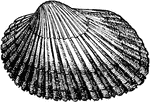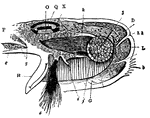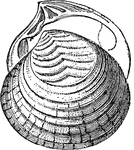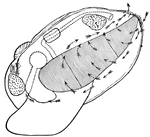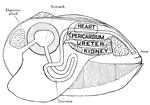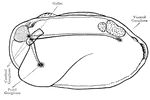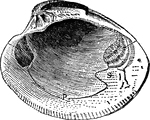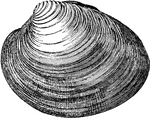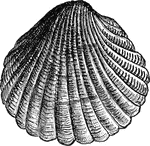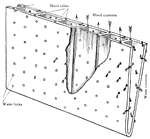The Clams and Other Bivalves ClipArt gallery features 148 illustrations of bivalves, including species of clams, mussels, scallops, and oysters.

Iphigenia Brasiliensis - Sinupalliate Right Valve
"Having a sinuous pallial margin and consequent sinuous impression on the shell along the line of attachment…
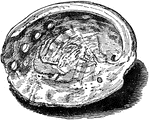
Abalone
"A general name on the Pacific coast of the United States for marine shells of the family Haliotidæ…
Accessory Valve
"Small additional valves, as those placed near the umbones of the Genus Pholas among mollusks."-Whitney,…
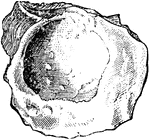
Aetheria semilunata
"A genus of bivalve mollusks, of the family Uniondæ, found in the rivers of Africa and Madagascar."-Whitney,…
Aspergillum Vaginiferum (Lamarck)
It has received the strange name of the Watering-pot because of a convex disk that is pierced with holes…
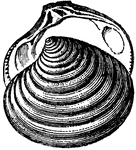
Astarte sulcata
"Astarte sulcata; In some systems of zoological classification, a family of dimyarian bi-valves, an…

Astarte sulcata
"Astarte borealis semisulcata. p,p', anterior and posterior pedal muscle."-Whitney, 1902.

Panopaea australis
"The Panopaea Australis is a large analogous species, found at Port Natal, on the coast of…

Balanus
A genus of sessile cirripeds, family Balanidae, of which colonies are to be found on rocks at low water.
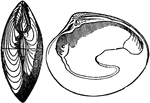
Bivalve
"Bivalves are those mollusks whose coverings consist of two concave shelly plates or valves united by…
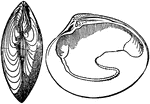
Bivalve
Shell of a bivalve, those mollusks whose coverings consist of two concave shelly plates or valves.
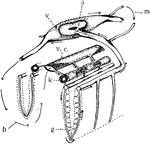
Bivalve Circulation
"Diagram showing the heart and general course of the circulation in the lamellibranchs. Only a short…
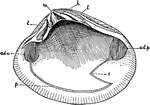
Bivalve Mollusk
"Shell of a Bivalve Mollusk, inner surface. ad.a., depression showing the attachment of the anterior…
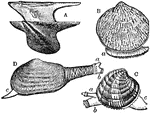
Forms of Bivalves
"Several Forms of Bivalves. A, Avicula; B, Pectunculus, with extended foot (a); C, Venus, with respiratory…

Cardium Aculeatum (Linnaeus)
"The familiar cockles are among the most widely distributed of shells. The greatest number are furnished…

Cardium Costatum (Linnaeus)
"The familiar cockles are among the most widely distributed of shells. An exotic species which inhabits…
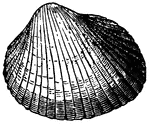
Cardium Edulis (Linnaeus)
"The familiar cockles are among the most widely distributed of shells. A species common to the Atlantic…
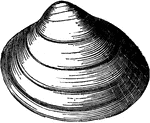
Cardium Groenlandicum (Chemnitz)
"The familiar cockles are among the most widely distributed of shells. The accessory ornamentation varies…

Clam
this is the common round clam of the Atlantic coast found from Texas to Cape Cod. It is frequently seen…
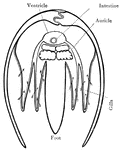
Clam
Cross section of the body of a clam, through the heart. Arrows indicate water current through the gills.
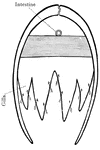
Clam
Cross section of the body of a clam, through the posterior adductor muscles. Arrows indicate water current…
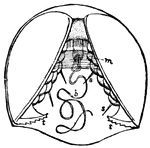
Clam
Young clam, still within the egg membrane. m, adductor muscle; t, hooks by which it attaches itself…

Clam
Anatomy of a bivalve clam. (ss) respiratory tubes; (aa) muscles by which the shell is closed (b) gills;…

Burrowing Clam
"Mya arenaria, a burrowing clam. The siphon is represented as fully extended. This is quickly retracted…
Razor Shell Clam
The razor shell clam has a shell somewhat resembling in shape and size the handle of a razor.

Clamshell
"a, a', impressions of the muscles; p, pallial line; s, bend occupied by the siphon; h, hinge; c, t,…
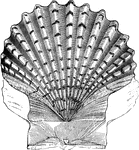
St, James' cockle
"Another species, St. James's cockle, P. Jacobaeus, having been adopted in the Middle Ages…
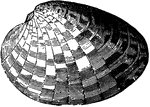
Cytherea Maculata (Linn.)
"Among the cast number of species belonging to the Veneridae family, many are extremely rare, and much…
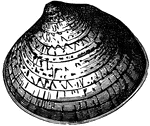
Cytherea Petechialis (Lamarck)
"Among the cast number of species belonging to the Veneridae family, many are extremely rare, and much…
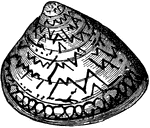
Cytherea Zonaria (Lamarck)
"Among the cast number of species belonging to the Veneridae family, many are extremely rare, and much…

Cytherea dione
"The posterior being besest by spines, and the sides furrowed with elevated lamellæ. The color…

Unio elongata
"The U. elongata is found in Great Britain, and formerly produced numerous pearly; these were…
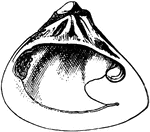
Right Valve of Galatea Bivalve
Galatea reclusa is a species of bivalve mollusk in the Donacidae family of bean clams (wedge shells).

Dorsal View of Gastrochaena
"Dorsal View of Gastrochaena. The ventral view shows the dried mantle with pedal perforation." -Whitney,…

Lateral View of Gastrochaena
"Lateral View of Gastrochaena. The ventral view shows the dried mantle with pedal perforation." -Whitney,…

Ventral View of Gastrochaena
"Ventral View of Gastrochaena. The ventral view shows the dried mantle with pedal perforation." -Whitney,…
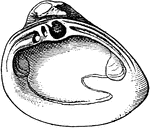
Gnathodon
"Gnathodon cuneatus. A bivalve mollusk. G. cuneatus is the cuneate clam of Louisiana." -Whitney, 1911
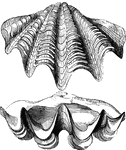
Shells of the great clam
"The Giant Clam, Tridacna gigas, is the largest of known shell-fish, the two valves sometimes…

Perna isognomum
"The Perna isognomum has a somewhat similar form to the Hammer Oyster; it lives in deep water,…
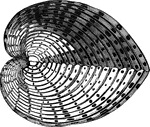
Cardium junonae
"The C. junonae is a very beautiful species. The great assemblage of the different kinds is…
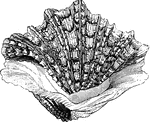
Hippopus maculatus
"The shells of the Hippopus maculatus are smaller but are more beatiful, and are used in the…

